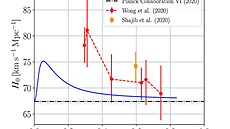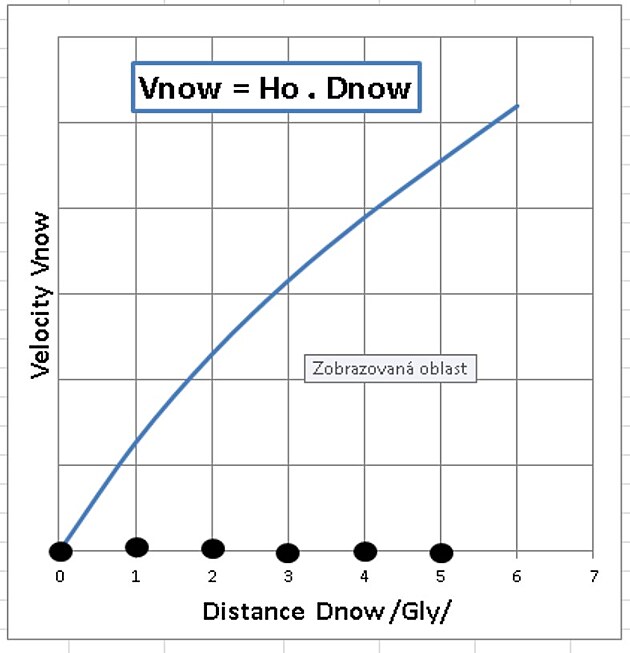- Napište nám
- Kontakty
- Reklama
- VOP
- Osobní údaje
- Nastavení soukromí
- Cookies
- AV služby
- Kariéra
- Předplatné MF DNES
The accelerated expansion of the universe caused by gravity and cosmological principle
Let's assume that the universe is flat, i.e. non-curved and Euclidean, on large scales from 1 Gly. Then Euclidean geometry and simple arithmetic for adding lengths and velocities suffice. Today we already know that the Hubble "constant" changes not only with time, but also with distance from us. Its present-day Ho value calculated from relict radiation is 67.4 km/s/Mpc, but for the nearby Universe it has been measured to be 73-74 km/s/Mpc (1). Ho therefore decreases with distance from us, this is also evident from the following graph (2).
If we allow this homogeneous universe to expand by the aforementioned nonlinear expansion, an inhomogeneous universe will emerge with the center of expansion at point 0, with clusters of galaxies no longer at equal distances from each other, because the nearby universe expands faster than the distant one.
This also disproves the cosmological principle that states that every observer is at the center of the expansion. We are near point 0, because the universe appears to us roughly the same in all directions, i.e. isotropic, but not homogeneous. The distant observer at point 3 is no longer at the center of the expansion because the galaxy clusters to his left are receding faster than those to his right. And its cluster is no longer in a weightless state, but is acted upon by the gravitational force Fg away from us and towards the higher density of space. In this way, the accelerated expansion of the universe, which has already been observed and can be caused by gravity and not by dark energy, can be simply explained.
Resources:
(1)New distance measurements bolster challenge to basic model of universe (phys.org)(2) KBC void and Hubble tension contradict ?CDM on a Gpc scale - Milgromian dynamics as a possible solution | Monthly Notices of the Royal Astronomical Society | Oxford Academic (oup.com)
Pavel Dudr
Zrychlené rozpínání vesmíru způsobené gravitací a vyvrácení kosmologického principu

Pavel Dudr
Americký expert: Jednota Německa a Ruska je pro nás jedinou hrozbou

Pavel Dudr
Trestný čin proti míru P. Fialy a J. Černochové - dodávky útočných zbraní na Ukrajinu

| Další články autora |

Jak předejít syndromu náhlého úmrtí kojence?
Syndrom náhlého úmrtí kojence (SIDS – sudden infant death syndrome) je doslova noční můrou všech rodičů. V současné době lze tomuto zbytečnému...
Střední školy
Nepřehlédněte
- Pašeráci v Indii lákali mladé na práci, skončili v ruské armádě. Organizátory zatkli
- Srbský basketbalista Jokič byl potřetí zvolen nejužitečnějším hráčem NBA
- Florida srovnala s Bostonem krok, Pastrňák se porval s Tkachukem
- Hvězdy NHL ozáří MS v Česku. Přijedou Hedman, Karlsson, Bedard či Tkachuk
- Slávistka Jiřina vyhrála lístky na hokej: A možná navštívíme i novou Síň slávy
- Necitlivé? Asistent rychle signalizoval těsný ofsajd Bayernu, sudí se omlouval
- Výkonný výbor TOP 09 schvaluje nominaci Ženíška na post ministra pro vědu
- Víkend bude oblačný s až 22 stupni, od pondělí opět deštivo i bouřky






